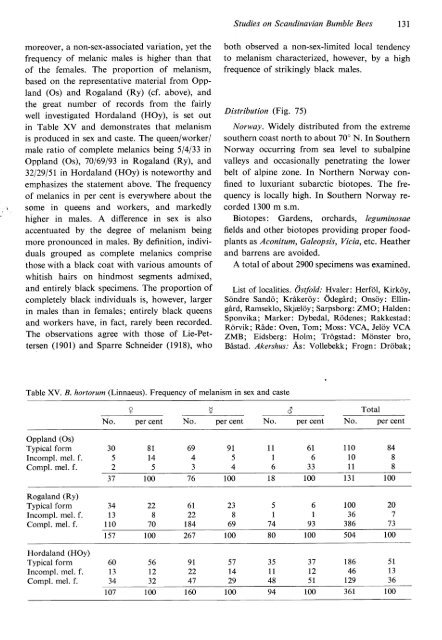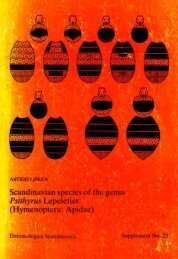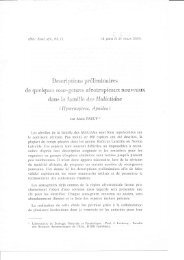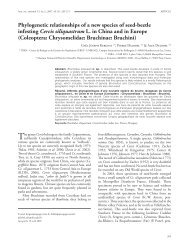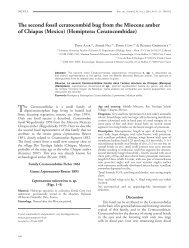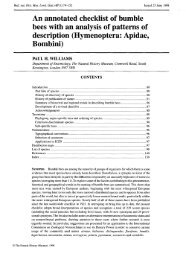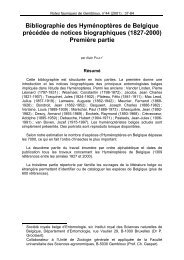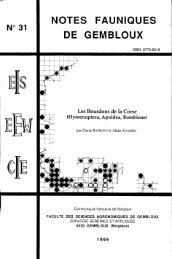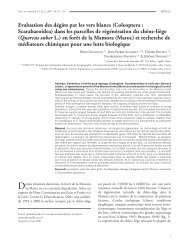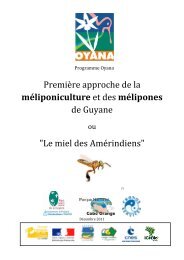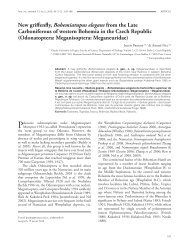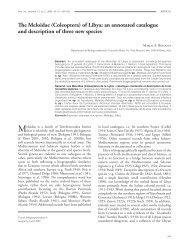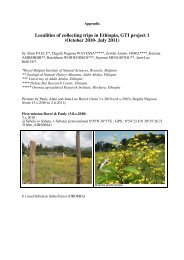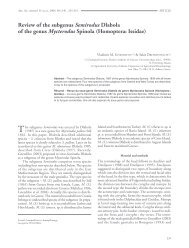Bumble Bees
Bumble Bees
Bumble Bees
Create successful ePaper yourself
Turn your PDF publications into a flip-book with our unique Google optimized e-Paper software.
Studies on Scandinavian <strong>Bumble</strong> <strong>Bees</strong>l3lmoreovet, a non-sex-associated variation, yet thefrequency of melanic males is higher than thatof the females. The proportion of melanisffi,based on the representative material from Oppland(Os) and Rogaland (RV) (cf. above), andthe great number of records from the fairlywell investigated Hordaland (HOy), is set outin Table XV and demonstrates that melanismis produced in sex and caste. The queen/worker/male ratio of complete melanics beine slqn inOppland (Os), 70169193 in Rogaland (Ry), and32129151 in Hordaland (HOV) is noteworthy andemphasizes the statement above. The frequencyof melanics in per cent is everywhere about thesome in queens and workers, and markedlyhigher in males. A difference in sex is alsoaccentuated by the degree of melanism beingmore pronounced in males. By definition, individualsgrouped as complete melanics comprisethose with a black coat with various amounts ofwhitish hairs on hindmost segments admixed,and entirely black specimens. The proportion ofcompletely black individuals is, however, largerin males than in females; entirely black queensand workers have, in fact, rarely been recorded.The observations agree with those of Lie-Pettersen(1901) and Sparre Schneider (1918), whoboth observed a non-sex-limited local tendencyto melanism characterized, however, by a highfrequence of strikingly black males.Distribution (Fig. 75)Norway. Widely distributed from the extremesouthern coast north to about 70" N. In SouthernNorway occurring from sea level to subalpinevalleys and occasionally penetrating the lowerbelt of alpine zone. In Northern Norway confinedto luxuriant subarctic biotopes. The frequencyis locally high. In Southern Norway recorded1300 m s.m.Biotopes: Gardens, orchards, leguminosaefields and other biotopes providing proper foodplantsas Aconitum, Galeopsis, Vicia, etc. Heatherand barrens are avoided.A total of about 2900 specimens was examined.List of localities. Astfold.' Hvaler: Herfol, Kirkoy,Sondre Sando; Krflkeroy: Odegflrd; Onsoy: Ellingird,Ramseklo, Skjreloy; Sarpsborg: ZMO; Halden:Sponvika; Marker: Dybedal, Rodenes; Rakkestad:Rorvik; Ride: Oven, Tom; Moss: VCA, Jeloy VCAZMB; Eidsberg: Holm; Trogstad : Monster bro,Bistad. Akershus: As: Vollebekk; Frogn: Drobak;Table XV. B. hortorum (Linnaeus). Frequency of melanism in sex and casteNo.dTotalper cent No. per cent No. per cent No. per centOppland (Os)Typical formIncompl. mel. f.Compl. mel. f.305281t4537 1006943769l5410011I6186l63310011010111318488100Rogaland (Ry)Typical formIncompl. mel. f.Compl. mel. f.Hordaland (HOV)Typical formIncompl. mel. f.Compl. mel. f.34 22 6l 23 5 6 100 2013 8 22 8 1 I 36 7110 70 184 69 74 93 386 73157 100 267 100 80 100 s04 10060133456l2329l224757t42935114837I251186461,29511336r07 100 160 100 100 361 100


